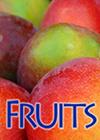Nutrient composition of Algerian strawberry-tree fruits (Arbutus unedo L.)
IF 0.5
4区 农林科学
Q4 HORTICULTURE
引用次数: 8
Abstract
Introduction. Arbutus unedo L. (strawberry-tree fruit) is indigenous plant in North Africa with few published works about the composition of its fruits. For their valorization, morphological and chemical characterizations were carried out for two harvesting seasons of four different areas of Algeria. Materials and methods. Wild strawberry-tree fruits were collected in four different sites located in Tell Atlas, and two different seasons. Fruit size and shape, pH, titratable acidity, moisture, total available carbohydrate (TAC), soluble sugars, dietary fiber, protein, lipid, ash, fatty acids and mineral composition (K, Na, Ca, Mg, Fe, Cu, Mn, Zn, Ni and Cd) were determined. Results and discussion. Fruit contents (in g kg) varied between 637.3 ± 33.8 to 741.3 ±12.0, 126.8 ± 11.1 to 189.3 ± 4.1, 22.6 ± 2.2 to 35.5 ± 2.1, 5.1 ± 0.3 to 8.8 ± 0.5 for moisture, TAC, protein and lipid, respectively. For iron, fruit weight and polyunsaturated fatty acids (PUFA), the contents varied between 7.01 ± 0.15 to 17.24 ± 0.74 mg kg of fruit, 4.91 ± 1.58 to 6.76 ± 2.04 g and 56.34 ± 1.37 to 68.18 ± 0.14% of lipid, respectively. Conclusion. This study provides original data about the morphological and chemical composition of strawberry-tree fruits from Algeria. The results show that the fruits can be essentially a potential source of dietary fiber, PUFA and iron.阿尔及利亚草莓果实的营养成分
介绍Arbutus unedo L.(草莓树果实)是北非的本土植物,很少有关于其果实成分的著作发表。为了对其进行估价,对阿尔及利亚四个不同地区的两个收获季节进行了形态和化学表征。材料和方法。在Tell Atlas的四个不同地点和两个不同的季节采集了野生草莓树果实。测定了果实大小和形状、pH值、可滴定酸度、水分、总有效碳水化合物(TAC)、可溶性糖、膳食纤维、蛋白质、脂质、灰分、脂肪酸和矿物质组成(K、Na、Ca、Mg、Fe、Cu、Mn、Zn、Ni和Cd)。结果和讨论。水分、TAC、蛋白质和脂质的果实含量(g kg)分别在637.3±33.8至741.3±12.0、126.8±11.1至189.3±4.1、22.6±2.2至35.5±2.1、5.1±0.3至8.8±0.5之间。铁、果实重量和多不饱和脂肪酸(PUFA)的含量分别为7.01±0.15至17.24±0.74 mg/kg、4.91±1.58至6.76±2.04 g和56.34±1.37至68.18±0.14%。结论本研究提供了阿尔及利亚草莓果实形态和化学成分的原始数据。结果表明,这些水果基本上可以成为膳食纤维、PUFA和铁的潜在来源。
本文章由计算机程序翻译,如有差异,请以英文原文为准。
求助全文
约1分钟内获得全文
求助全文
来源期刊

Fruits
HORTICULTURE-
CiteScore
1.10
自引率
0.00%
发文量
22
审稿时长
>12 weeks
期刊介绍:
The scope of Fruits - the International Journal of Tropical and Subtropical Horticulture includes:Fruits - The International Journal of Tropical and Subtropical Horticulture
-crop production and cropping systems,
-breeding,
-genetics and
-the release of genetic material adapted to tropical and subtropical environments,
management,
-storage and market supply of underutilized crops,
-integrated management of pests and diseases,
-clinical relevant effect of tropical and subtropical horticultural species,
-peri-urban and urban tropical crop production,
-sustainable water and input use,
-capacity building in horticulture,
-value chain development in developing countries,
-seed science and agricultural engineering.
Fruits, The International Journal of Tropical and Subtropical Horticulture, deals with such crops as vegetables, fruits, spices, ornamentals and medicinal plants growing in the tropical and subtropical environment.
 求助内容:
求助内容: 应助结果提醒方式:
应助结果提醒方式:


